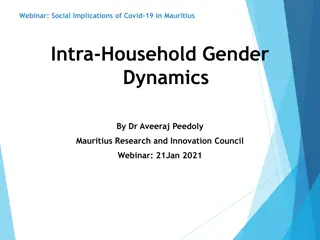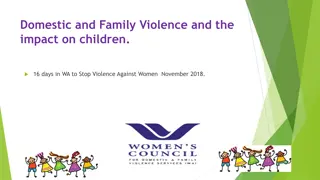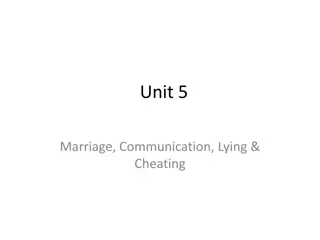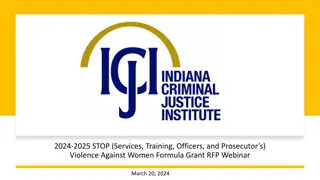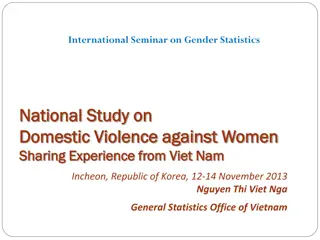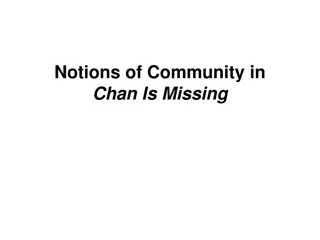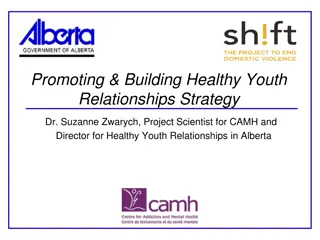Cultural Considerations in Domestic Violence Within Asian Pacific Islander & Middle Eastern Communities
Explore important considerations for advocates, health care workers, and community members working with Asian Pacific Islander and Middle Eastern communities affected by domestic violence. Understand different types of abuse, cultural nuances, and how to provide support while being mindful of triggers and diverse perspectives.
Download Presentation

Please find below an Image/Link to download the presentation.
The content on the website is provided AS IS for your information and personal use only. It may not be sold, licensed, or shared on other websites without obtaining consent from the author. Download presentation by click this link. If you encounter any issues during the download, it is possible that the publisher has removed the file from their server.
E N D
Presentation Transcript
DOMESTIC VIOLENCE IMPORTANT CONSIDERATIONS FOR ADVOCATES, HEALTH CARE WORKERS, AND COMMUNITY MEMBERS WHEN WORKING WITH ASIAN PACIFIC ISLANDER & MIDDLE EASTERN COMMUNITIES Vinder Lallian, MA, LMFT Licensed Marriage and Family Therapist, MFC#52026 Counseling Director for My Sister s House Certified Clinical Trauma Professional (CCTP)
TODAY Learn about the different types of domestic violence Identify and discuss cultural considerations when working with the Asian Pacific Islander (API) and Middle Eastern (ME) communities Do s and Do Not s of how to support a possible victim of DV Red flags in a health care setting Resources
DISCLAIMERS Victims and abusers can be of any gender, sexual orientation, race or religion Victim and survivor are terms that I may use interchangeably For today s presentation, I will use pronouns she/her for the victim and him/he for the abuser. Clients may have different feelings that come up for them around both of those words, so we can adjust according to what they want/need/say This is a very difficult topic You may be triggered so please do take care of yourself during and after the presentation
WHAT IS DOMESTIC VIOLENCE (DV) Intimate partner violence (IPV)- simply is domestic violence that is happening within a romantic/intimate relationship with a partner, spouse, or ex-partner regardless of sexuality. Domestic violence any type aggression/violence that is occurring within a domestic (home) environment. This includes IPV When working with the API/ME communities, we notice that both of these types of situations are happening. Often, society does not consider verbal abuse and threats coming from a mother-in-law as domestic violence. However, we know than be more common in these communities.
PHYSICAL ABUSE GOAL: Instill FEAR and maintain POWER & CONTROL Hitting Kicking Slapping Spitting Pulling hair Strangulation Not allowing one to leave Using restraints
VERBAL ABUSE GOAL: Break down the self-esteem of the victim Name-calling Making negative comments Judgmental Critical Negativity Not what they are saying, but the message that is being sent
SEXUAL ABUSE GOAL: Instill FEAR and maintain POWER & CONTROL Non consensual sexual touch Forced sexual engagement Consequences if you do not comply Participating on to avoid other types of abuse If you don t do X, then I will go get it elsewhere threats Sex trafficking Forced to use drugs/alcohol before sex Not allowing use of birth control Forced pregnancy
WHAT IS SEXUAL ASSAULT Sexual assault can take many different forms Any unwanted sexual advances or touch Rape, penetration of the victim s body Note that sexual assault does not mean only rape. Rape is just one form of sexual assault Force or coercion to perform sexual acts. Force is not always physical. It can be verbal, emotional and mental
MENTAL ABUSE GOAL: Victim is CRAZY Victim may become confused Victim may start to self doubt and have trouble identifying what is reality Abusers tells the victim that she is crazy If not physical abuse, comments that she is not a victim since he is not touching her Mental health struggles (Depression and Anxiety) Charming in front of others but abusive to you Isolation leads to struggling in so many ways Jealousy and control
EMOTIONAL ABUSE GOAL: Break down SELF-ESTEEM and DISEMPOWER All the different types of domestic violence are all a form of emotional abuse Not feeling safe Living in fear Feeling unwanted Feeling unworthy Feeling confused Accusations of being unfaithful Long lasting effects
FINANCIAL ABUSE GOAL: Maintain POWER and DEPENDENCY on abuser Not allowing victim to work Not allowing any freedom to spend Allowance given Receipts collected Forcing victim to work but not allowing access to money Only allowed to purchase with approval of abuser
SPIRITUAL ABUSE GOAL: Break down the SPIRIT, take away HOPE/JOY and COPING Not allowing or supporting you to practice your religion Not allowing or supporting you to practice cultural rituals Making negative comments Not participating Not allowing children to participate Forcing the victim to convert religions Not allowing victim to go to mosque/temple/gurudwara
ISOLATION #1 tool of the abuser Creates dependency Allows and sets the stage for brainwashing Increases dependency on the abuser Decreases independence Control access to knowledge and resources Reduces support system for the victim Examples: he doesn t like her family, does not allow her to talk to family, control who she talk to, talks negatively about her friends. Eventually she pulls away
STRANGULATION Any external pressure to the neck by any means that blocks airflow or blood flow Most lethal form of violence Often victims say choke Men who strangle are killers Research indicates that stranglers are very likely to become stalkers Link to police shooting, mass shooting, etc. Takes only 2 seconds to go into unconsciousness Men who strangles are more like to abuse animals and be sexually abusive Victims of strangulation are linked to higher rates of suicide due to a loss of hope Reference is www.strangulationtrainininginstitute.com
LONG-TERM AND SHORT-TERM EFFECTS OF DOMESTIC VIOLENCE Depression Anxiety Post-Traumatic Stress Disorder Substance Use Isolation Lack of resources Physical symptoms for API/ME
CULTURAL CONSIDERATIONS What do you think of when you think of domestic violence? Is there a word(s) for domestic violence in your language if other than English? What are some assumptions or myths about domestic violence in API/ME cultures? Is domestic violence normal or expected within the API/ME community? Does your culture/religion consider one to be a victim of DV without physical abuse?
ROLE OF CULTURE Gender stereotypes Patriarchal culture Victim blaming Shame Collectivistic vs. Individualistic approach
IMPACT OF CHILDREN Very big reason by API/ME communities want to stay together Victims think they are sacrificing for the well being of their family Threats in the family about what they will do with the children Abusers may tell children that their mother is selfish or wants to take the children away Parental alienation Children are the most important even though the domestic violence is damaging the them Example of Hmong culture
IMMIGRATION Key piece of the puzzle for many API/ME victims Immigration status No work permit Do not allow for immigration process, some excuse always Fear induction Go ahead and call the police, you will get deported Language barriers New immigrants do not have the knowledge about the U.S. and the laws
SAFETY PLANNING Stay calm Start working towards a plan If the victim has a good plan, the victim will be more successful Victims are at the greatest risk when the leave Documents, important information, must all be slowing collected, copied, etc. before making a plan to leave Once victim leaves, she is essentially escaping DO NOT communicate with the abuser
DOS AND DO NOTS Slow down Victim is the expert Remind the victim that she does not have to do anything she is not ready to do Do not judge Do not pressure Safety plan Remind them about the facts you learned about children growing up in a home with domestic violence Very important that as the victim plans to leave, she has to be careful that he/they do not find out Do not assume that she wants an advocate that is of the same culture Every victim and every situation is different Must make a rational/logical decision and not an emotional decision
MEET THEM WHERE THEY ARE They may not know they are a victim Provide resources in a subtle and safe way Validate their feelings Listen Victims are the experts in their own life Provide education about healthy relationship Provide education around laws and resources (she may be very misinformed) Provide as much education around isolation and why isolation is dangerous
RED FLAGS IN HEALTH CARE SETTINGS Is the patient quite? Does the partner/spouse/family member speak for the patient Does the patient s spouse/family member refuse to wait in the waiting room Does the patient have physical injuries that may not align with the story. Does the patient describe chronic pain, headaches, nausea, etc. Inquire about social well-being (friends, parents, etc) Isolation is the #1 tool of the abuser (access to support) Have resources available including a business card that you can discretely give to the potential victim. Medical decisions should be confirmed by using an interpreter
WHAT TO DO If patient requires an interpreter, get one Request interpreter if support person is speaking for the client. Do not rely on the person with her Tell the spouse/family member that you d like to assess the client privately Does the patient understand the treatment etc. (abortion example) Do not use words like domestic violence because patient may not know what that is. Ask for example Do you feel safe at home? Is any one hurting you? Watch for non verbal communication and emotion or avoidance. Head down, refusing eye contact, looking afraid
RESOURCES AND SERVICES Utilize and encourage the use of interpreters Work on breaking down the mental health stigma Describe therapy or counseling in a way that describes it truly for what it is I always say, Just try one session. Groups can be a very supportive environment but it there can also be shame and fear Every client is different Do not instill fear, rather validate and support Praise and encourage since self esteem may be negatively impacted by DV
RESOURCES My Sister s House website to learn more: www.my-sisters-house.org My Sister s House 24/7 multilingual line : 916-428-3271 Domestic Violence Education and Support group Women to Work program in English and Spanish Healing thru Art National Suicide Prevention Hotline is 800-273-8255 Rape, Abuse & Incest National Network (RAINN) www.rainn.org Strangulation resources www.strangulationtraininginstitute.com
PLEASE CONTACT ME DIRECTLY WITH ANY QUESTIONS AT VLALLIAN@MY-SISTERS-HOUSE.ORG












